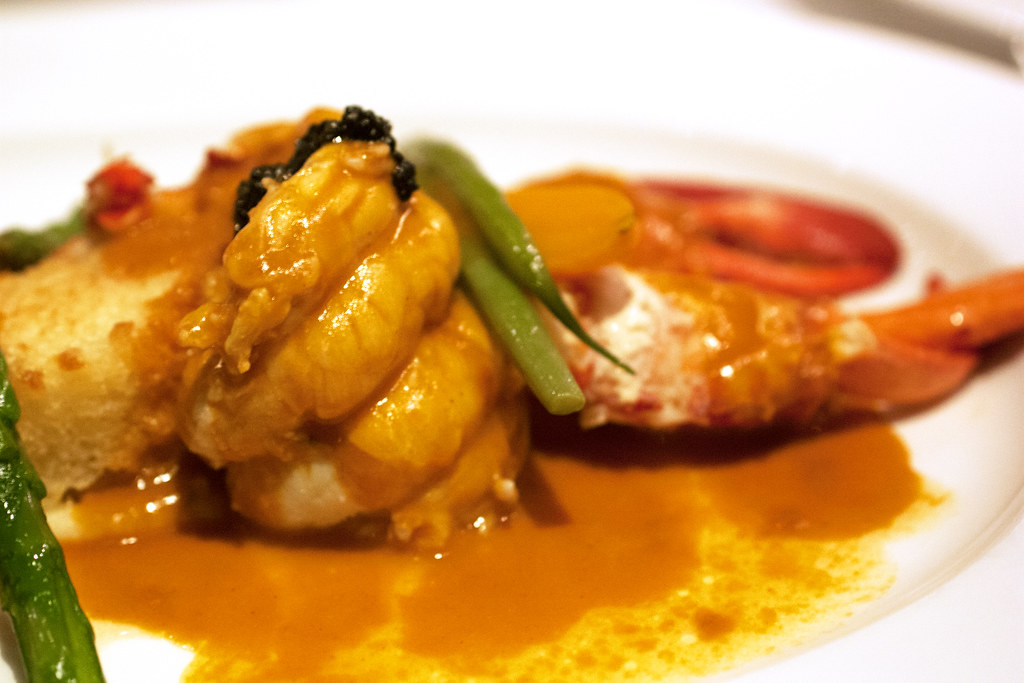Ah, yes - here's another two-fer. I wrote this one for this month's community magazine, and I've had a few favorable comments on it. We've all been speculating about the answer to the last sentence.
 |
Lobster Newburg - I haven't had this in years!
Ingredients include cream, sherry, cognac, butter, and, of course, lobster.
Scrumptious! |
Do you remember Lobster Newburg, Salisbury steak, Chicken a la King,
and that all-time favorite Creamed Chipped Beef on Toast? This last one was
also known to many of us as Sh.. …well,
let’s just say that time marches on and, fortunately for us, so have the trends
for what we eat.
We were accustomed to calorie-dense foods, foods that were relatively
inexpensive but filled us and provided the calories for hard work and play.
Noodles, pasta, potatoes, and bread played a big part in our diets. Unless it
was spaghetti night, supper was meat, a starch, and a veg. Salads made very
rare appearances on our plates. Farmers markets were few and far between, and
unless your family maintained a vegetable garden, your veggies were days, even
weeks old. The butcher, the baker, the green grocer, and the milk man, were the
common independent purveyors who now find themselves under one roof in the
supermarket.
Sundays were the days for a huge roast, perhaps leg of lamb or fresh
ham, and all the accompaniments. Mom spent a lot of the morning preparing the
roast, and the rest of the family spent the late afternoon working or snoozing
off the effects of the meal. Today, such large roasts are served mostly on
holidays. Many Baby Boomers don’t even remember a fresh ham, thinking it’s the
non-canned variety of a smoked ham.
While weeknight desserts were things like jello, chocolate pudding, or
tapioca, Sunday desserts were presentations: pound cakes, layer cakes,
pineapple upside-down cakes, coconut cream pies, pies of every flavor, and, in
season, things like buckles and cobblers. In summer there might have been a
treat of home-made ice cream.
In the Fifties, while we on the western side of the Atlantic were
eating these traditional foods, people like Julia Child were over in France
learning new ways to cook. No longer was Chinese cooking just chop suey or chow
mein. No longer was Asian cooking just Chinese. No longer were chop suey and
chow mein or spaghetti and pizza the only international foods on our plates.
Television, advances in freezing foods, and widespread transportation
meant that we were getting a larger variety of fresher foods and were learning
new ways to prepare them. No longer did one cookbook cover everything we wanted
to prepare. Fanny Farmer, Better Homes and Gardens, or the Settlement cookbook,
have been joined on the packed shelves by hundreds of others. The vast variety
of subjects to be covered in individual cookbooks meant that book stores moved the few cookbooks out of the Reference section, and began to devote whole
sections of their shelves to them.
Today we aren’t as reliant on seasonal foods, although eating with the
seasons, becoming a “locavore” and cooking with what is readily available from
nearby sources, is the latest trend, especially for restaurants. Many
restaurants don’t have freezers, preferring to use only the freshest
ingredients for their menu. And that’s another difference in the way we eat
today: more and more we choose to eat out. Rather than stock our kitchens with
all the ingredients for international cuisines, we go to the local places that
satisfy our tastes. Just in our area we can have Asian, Italian, Greek,
Mexican, New York Deli, Southern, you name it, breakfast, lunch, or dinner, and
it’s nearby. So much food, so little time!
Just wonderin’…
…Remember the party standby, deviled eggs? Just plain deviled eggs.
Today, according to a recent issue of Saveur magazine, they marinate the
whites in soy sauce and raspberry vinegar - just for fifteen minutes, mind you
- and then fill them with the yolks that were combined with lump crab meat,
avocado, and apple. Chefs are getting inventive. Food is getting fancy. It’s
probably a good thing, but we have to wonder what “comfort food” will be to
generations to come.




